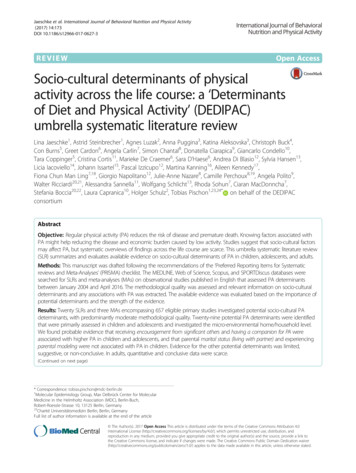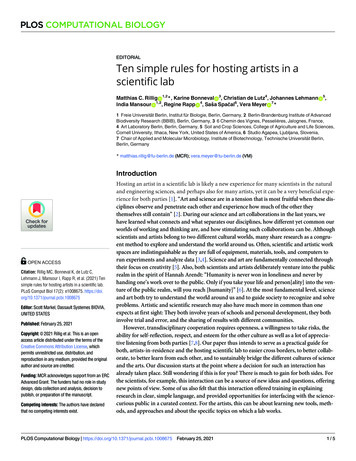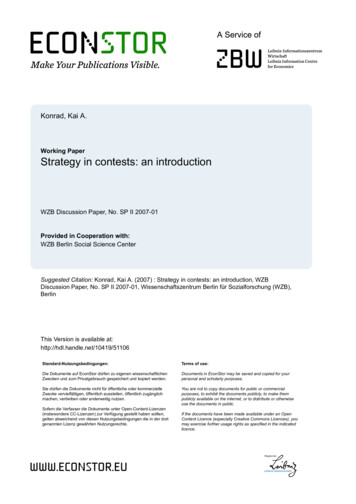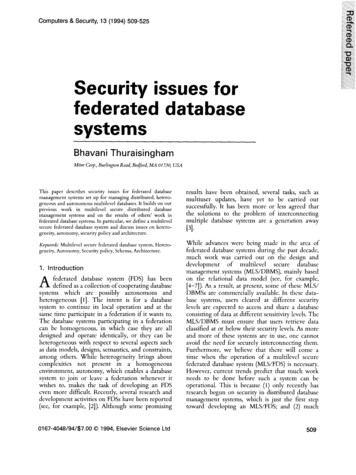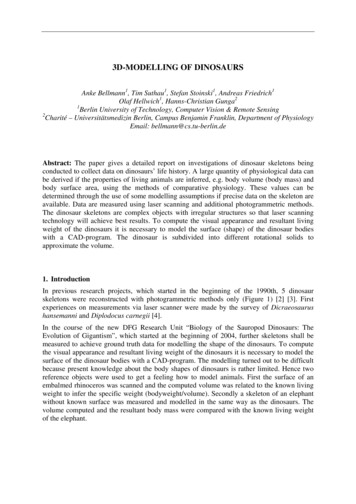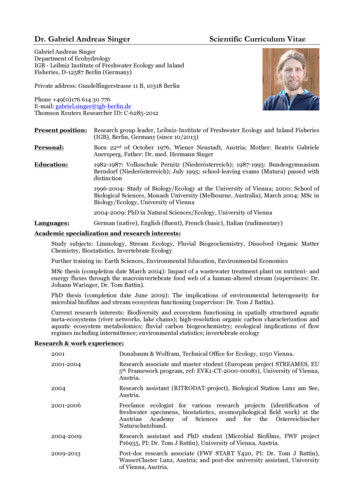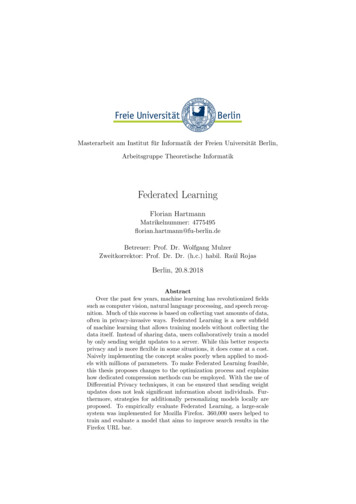
Transcription
Masterarbeit am Institut für Informatik der Freien Universität Berlin,Arbeitsgruppe Theoretische InformatikFederated LearningFlorian HartmannMatrikelnummer: 4775495florian.hartmann@fu-berlin.deBetreuer: Prof. Dr. Wolfgang MulzerZweitkorrektor: Prof. Dr. Dr. (h.c.) habil. Raúl RojasBerlin, 20.8.2018AbstractOver the past few years, machine learning has revolutionized fieldssuch as computer vision, natural language processing, and speech recognition. Much of this success is based on collecting vast amounts of data,often in privacy-invasive ways. Federated Learning is a new subfieldof machine learning that allows training models without collecting thedata itself. Instead of sharing data, users collaboratively train a modelby only sending weight updates to a server. While this better respectsprivacy and is more flexible in some situations, it does come at a cost.Naively implementing the concept scales poorly when applied to models with millions of parameters. To make Federated Learning feasible,this thesis proposes changes to the optimization process and explainshow dedicated compression methods can be employed. With the use ofDifferential Privacy techniques, it can be ensured that sending weightupdates does not leak significant information about individuals. Furthermore, strategies for additionally personalizing models locally areproposed. To empirically evaluate Federated Learning, a large-scalesystem was implemented for Mozilla Firefox. 360,000 users helped totrain and evaluate a model that aims to improve search results in theFirefox URL bar.
Eidesstattliche ErklärungIch versichere hiermit an Eides Statt, dass diese Arbeit von niemand anderem als meiner Person verfasst worden ist. Alle verwendeten Hilfsmittelwie Berichte, Bücher, Internetseiten oder ähnliches sind im Literaturverzeichnis angegeben, Zitate aus fremden Arbeiten sind als solche kenntlichgemacht. Die Arbeit wurde bisher in gleicher oder ähnlicher Form keineranderen Prüfungskommission vorgelegt und auch nicht veröffentlicht.Berlin, 20. August 2018(Florian Hartmann)
AcknowledgementsMany people have supported me while writing this thesis. First of all, Iwould like to thank Wolfgang Mulzer for advising me on this thesis and forproviding so much helpful feedback, even when I was not in Berlin.A major part of this thesis was developed during my time at Mozilla inMountain View. I am very thankful for the research-friendly environmentthat Mozilla provided and greatly appreciate how open Mozilla is in its work.Sunah Suh made it possible to launch my code to Firefox Beta andhelped to resolve many problems along the way. For this support and foralways having an open ear to my problems, I would like to wholeheartedlythank her. I also want to express my gratitude to Arkadiusz Komarzewskifor being so interested in the project and for porting my Python server-sideimplementation to Scala.Furthermore, I want to extend my thanks to Drew Willcoxon and RobHelmer, who helped me navigate the Firefox specific parts of the project.I also want to thank Katie Parlante for making it possible to work on mythesis at Mozilla and for being so incredibly supportive of my ideas.I would like to thank Rishi Bommasani for reading several drafts of thethesis, for all his feedback and for the nice time we shared in California. Ialso want to thank Anthony Miyaguchi for all the interesting conversationswe had in the Mountain View office, some of which revolved around thisthesis.Finally, I would like to thank my parents for always encouraging me inall my endeavors. I deeply appreciate all the support I received over theyears.
Contents1 Introduction1.1 Motivation . . . . . .1.2 Structure of the Thesis1.3 Federated Learning . .1.4 Applications . . . . . .112362 Background2.1 Estimators . . . . . . . . . . . . . . . . . . . . . . . . . . . . .2.2 Gradient Descent . . . . . . . . . . . . . . . . . . . . . . . . .2.3 Computational Graphs . . . . . . . . . . . . . . . . . . . . . .9910133 Federated Optimization3.1 Distributed Training Data . . . . . . .3.2 Sampling Techniques . . . . . . . . . .3.3 Improving Individual Update Quality3.4 Early Stopping . . . . . . . . . . . . .3.5 RProp . . . . . . . . . . . . . . . . . .1515161819214 Compression4.1 Communication Cost . . . . . . .4.2 Sketched Updates . . . . . . . . .4.2.1 Sparse Masks . . . . . . .4.2.2 Probabilistic Quantization4.3 Structured Updates . . . . . . . .4.3.1 Sparse Masks . . . . . . .4.3.2 Matrix Decomposition . .4.4 Updates for RProp . . . . . . . .4.5 Compression-Sampling Tradeoff .26262728293232333535.5 Privacy375.1 Motivation . . . . . . . . . . . . . . . . . . . . . . . . . . . . 375.2 Differential Privacy . . . . . . . . . . . . . . . . . . . . . . . . 385.3 Differentially-Private Federated Learning . . . . . . . . . . . 396 Personalization6.1 Motivation . . . . . .6.2 Transfer Learning . . .6.3 Personalization Vector6.4 Simulations . . . . . .4343444546
7 Implementation7.1 Search in Firefox . . .7.2 Optimization . . . . .7.3 Simulations . . . . . .7.4 Study Design . . . . .7.5 Analyzing the Results8 Conclusion.49495257596168
Notation At a given time:– There are k users in total– They have n data points in total– ni data points are from the i-th user In each iteration:– K users sampled– These users have N data points– Hi is the update proposed by the i-th user Statistics:– η is the learning rate– θ are the weights of the model– m is the number of weights– f is the prediction function of a model– L is the total loss of the model over a dataset– X̃ is an estimator of a value X Data:– xi and yi respectively are the i-th data point and label in total– xij and yij are the j-th data point and label of the i-th user is the gradient operator, or, more generally, a function that computes a model improvement based on the loss
1 Introduction11.1Florian HartmannIntroductionMotivationMany problems in computer science are tremendously difficult to solve byhandcrafting algorithms. Speech recognition systems are a prominent example of this. The audio recordings that need to be analyzed consist of hugeamounts of high-dimensional data. Understanding this data well by manualinspection is virtually impossible.Machine learning provides an alternative approach to solving such problems. It is often referred to as the field of learning from example data [12, 30].By collecting data and then applying statistical techniques, patterns can befound in an automated way. In the example of speech recognition, one wouldcollect a large amount of audio recordings and their respective transcriptions.Machine learning algorithms can then find patterns in the audio data thathelp with interpreting the audio signals [40].In the past few years, this idea has been successfully applied to manydifferent areas [54]. Speech recognition and recommender systems are mostlybased on machine learning nowadays [36, 40, 77]. The areas of computervision and natural language processing also increasingly rely on data-drivenapproaches. For example, most state-of-the-art solutions in object detectionand machine translation are based on learning from data [52, 6].Many learning algorithms that are now extremely successful have beenknown for many years. For instance, the backpropagation algorithm, whichmost of deep learning is based on, was described as early as in 1970 [57, 37].To explain why these ideas are only now being used successfully, three reasons are generally given. First, there have been some fundamental improvements to the algorithms that had a great effect. To give just a single example,Adam has greatly reduced the amount of tuning that is required to makegradient descent work well [49].A second reason for the recent success has been the increase in computational resources that are available. Processing power has repeatedlydoubled over the years [59] and special hardware for linear algebra and machine learning has been released [48]. However, the third reason, and oftenconsidered the most central one, is that more data to train on is available.Having more example data means that the algorithms get more informationto decide what patterns are truly important. Consequently, it is less likelythat example data points are just memorized or that random patterns aredetected as a useful signal.An impressive demonstration of the value of having more data was givenby Facebook in May 2018 [93]. By training an object detection modelusing 3.5 billion Instagram images [21], they outperformed all other modelson ImageNet, the standard benchmark for object recognition [24]. Eventhough the methods used to analyze the data were not completely new, the1
1.2Structure of the ThesisFlorian Hartmannhuge amount of data helped them to build the best object detection model todate. The fact that having a lot of data is extremely important in buildinggood machine learning models has been widely described and discussed [38].The predominant way of using machine learning nowadays involves collecting all this data in a data center. The model is then trained on powerful servers. However, this data collection process is often privacy-invasive.Many users do not want to share private data with companies, making itdifficult to use machine learning in some situations, e.g. when medical datais involved. Even when privacy is not a concern, having to collect data canbe infeasible. For example, self-driving cars generate too much data to beable to send all of it to a server [101].Federated Learning [63, 50] is an alternative approach to machine learning where data is not collected. In a nutshell, the parts of the algorithmsthat touch the data are moved to the users’ computers. Users collaboratively help to train a model by using their locally available data to computemodel improvements. Instead of sharing their data, users then send onlythese abstract improvements back to the server.This approach is much more privacy-friendly and flexible. Applicationson mobile phones provide examples where this is especially evident. Usersgenerate vast amounts of data through interaction with the device. Thisdata is often deeply private in nature and should not be shared completelywith a server. Federated Learning still allows training a common modelusing all this data, without necessarily sacrificing computational power ormissing out on smarter algorithms. Here, Federated Learning approachescan even lead to better models than conventional techniques since moredata is available.1.2Structure of the ThesisIt is the goal of this thesis to give an introduction to Federated Learningand to provide an overview over solving various related problems. Since thefield is still fairly new as of 2018, the aim is to provide a complete guide ondeveloping a Federated Learning system. For aspects that were previouslysuggested as future research areas, such as personalizing models [64], wepropose new approaches. Additionally, the goal is to demonstrate empirically that Federated Learning does not only work in simulations but canalso work in complex software projects.The remainder of this thesis is structured as follows: The field of Federated Learning is defined and formalized in Section 1.3. The fundamentalproperties and the protocol introduced in that section serve as a basis forall other chapters. The necessary background knowledge to understand thisthesis is given in Section 2.The next two sections focus on making Federated Learning more efficient. Section 3 deals with various aspects related to the optimization2
1.3Federated LearningFlorian Hartmannprocess. Compression techniques for reducing the communication effort areintroduced in Section 4.In Section 5, privacy-specific aspects of Federated Learning are discussed.Using Differential Privacy [26], it can be ensured that it is virtually impossible to make conclusions about what data individuals used to help train themodel. Allowing personalized models, while still collaboratively helping totrain a central model, is the topic of Section 6.An implementation of a Federated Learning system for Mozilla Firefoxis discussed in Section 7. Finally, Section 8 gives an overview over all thetopics covered and provides a short conclusion.1.3Federated LearningIn supervised learning, n example inputs and the corresponding outputs aregiven:Example inputs x1 , . . . , xnoutputs y1 , . . . , ynThis example data is sampled from some underlying distribution that is notknown to us. The goal is to find a function f that maps from example inputsto outputs sampled from this distribution. To do this, we decide on the formof the function and then optimize the variable parts of it. For example, thiscould mean fixing the function to be linear and then finding the best possiblecoefficients. Because only some example data is available, the goal is to finda function that maps well from the example inputs to the outputs under theconstraint that it also needs to work as well for new data sampled from thesame distribution.In other areas like unsupervised machine learning, the example outputsmight be missing and the success criteria for f are defined differently [33].The variable parts of the function which are optimized during the learningprocess are called parameters or weights. Values that need to be set beforethe training begins are called hyperparameters. Generally, these are muchmore difficult to optimize [35].In order to use conventional machine learning techniques, the n datapoints are collected and the training process is performed on a server. Thisis in contrast to Federated Learning, where the explicit requirement is thatusers do not have to share their data. Instead, the n data points are partitioned across the computers of k users. Users can have varying numbers ofdata points, so ni denotes how many examples the i-th client has access to.Most machine learning algorithms work in an iterative process wherethey repeatedly look at example data. They start off with an initial solutionand then continually try to improve it. In each iteration, the model isevaluated using the training data and then updated. Each update is meantto improve the model’s performance on the training data a little bit.3
1.3Federated LearningFlorian HartmannTo avoid collecting the training data, a distributed way of running thelearning algorithm is required. The parts of the algorithm that directlymake use of the data need to be executed on the users’ computers. Thesecorrespond to the sections of the algorithm that compute the previouslymentioned updates. In Federated Learning, users compute updates basedon their locally available training data and send them to a server. Theseupdates are much harder to interpret than pure data, so this is a majorimprovement for privacy. For some applications with huge amounts of data,it might also be cheaper to communicate the updates compared to directlysending the data.While the computers of users generally have much less computationalpower than servers in a data center, there is also less data on them. Byhaving a lot of users, the computations that need to be performed are vastlydistributed. There is not much work to do on the computer of each individual.Conventional machine learning can be seen as a centralized system whereall the work is performed on one server. In the process described so far, responsibilities are moved from the server to the clients. This is not a fullydecentralized system because the server still runs a part of the algorithm. Instead, it is a federated system: A federation of clients takes over a significantamount of work but there is still one central entity, a server, coordinatingeverything.Before the server starts off the distributed learning process, it needs toinitialize the model. Theoretically, this can be done randomly. In practice,it makes sense so smartly initialize the model with sensible default values.If some data is already available on the server, it can be used to pretrainthe model. In other cases, there might be a known configuration of modelparameters that already leads to acceptable results. Having a good firstmodel gives the training process a headstart and can reduce the time ittakes until convergence.After the model has been initialized, the iterative training process iskicked off. A visualization of the steps performed in each iteration is shownin Figure 12. At the beginning of an iteration, a subset of K clients arerandomly selected by the server. They receive a copy of the current modelparameters θ and use their locally available training data to compute anupdate. The update of the i-th client is denoted by Hi . The updates arethen sent back to the server.In this thesis, we generally assume θ and Hi to be vectors in Rm . However, the same concepts transfer directly to any sequence of vectors sincethey can be concatenated into one long vector.The server waits until it has received all updates and then combines theminto one final update. This is usually done by computing an average of allupdates, weighted by how many training examples the respective clients4
1.3Federated LearningFlorian Hartmann(a) The server selects K users(b) They receive the current model(c) and compute updates using their data (d) Updates are shared with the serverFigure 1: One communication round in a Federated Learning systemused. The update is then applied to the model usingθ θ KXnii 1PKNHi(1)where N i 1 ni is the total number of data points used in this iteration.A new iteration begins after every model update.In each iteration only K users are queried for updates. While requestingupdates from all users would lead to more stable model improvements, itwould also be extremely expensive to do because there can be millions ofusers. Only querying a subset of them makes it more feasible to efficientlyrun many iterations.This training process is then repeated until the model parameters converge, as determined by an appropriate criterion. In some situations, itcan also make sense to keep the training running indefinitely. In case userpreferences change, the model will automatically adapt correspondingly. Independently of the length of the training process, new models should bedistributed to all clients from time to time. This ensures that they have agood model to use locally.Federated Learning might seem similar to distributed machine learning in a data center. Parts of the problem setting are indeed comparable.Data is distributed across compute nodes, or users. Algorithms are used5
1.4ApplicationsFlorian Hartmannin a MapReduce [23] kind of a way where updates are calculated on manycomputers at the same time and then combined afterwards [19].However, Federated Learning is a vastly more distributed way of collaboratively training machine learning models. It can be distinguished byseveral key properties. These also describe the some of the challenges inFederated Learning:1. A huge number of users: In a data center, there might be thousandsof compute nodes. Popular consumer software has several orders ofmagnitude more users than that. All of these users should be able toparticipate in training the model at some point, so Federated Learningneeds to scale to millions of users2. Unbalanced number of data points: It is easy to guarantee thatcompute nodes have a similar number of data points in a data center.In Federated Learning, there is no control over the location of data atall. It is likely that some users generate vastly more data than others3. Different data distributions: Even worse, no assumptions aboutthe data distributions themselves can be made. While some usersprobably generate similar data, two randomly picked users are likelyto compute very different updates. This is also unfortunate from atheoretical standpoint because no iid [25] assumptions can be made,i.e. random variables are generally not independently and identicallydistributed4. Slow communication: Since compute nodes in Federated Learning correspond to users’ computers, the network connections are oftenbad [106]. This is especially the case if the training happens on mobile phones [105]. Updates for complex models can be large, so this isproblematic when training more sophisticated models5. Unstable communication: Some clients might not even be connected to the internet at all when the server asks them to send backmodel updates. In a data center, it is much easier to guarantee thatcompute nodes stay onlineIn a nutshell, Federated Learning is a massively distributed way of training machine learning models where very little control over the compute nodesand the distribution of data can be exercised. The properties listed abovemotivate several of the next chapters.1.4ApplicationsThe protocol introduced so far is fairly abstract and it remains to be discussed what exactly can be implemented with it. In general, it is possible6
1.4ApplicationsFlorian Hartmannto use Federated Learning with any type of models for which some notion ofupdates can be defined. It turns out that most popular learning algorithmscan be described in that way.A large part of machine learning is based on gradient descent, a popularoptimization algorithm that is described in more detail in Section 2.2. Gradient descent naturally transfers well to Federated Learning. The updatesare partial derivatives that define in what direction the model parametersshould be moved. Linear regression, logistic regression and neural networksare generally all optimized using gradient descent [35, 12]. Linear supportvector machines and matrix factorization based methods, like collaborativefiltering, can also be optimized with this method [72, 32, 51].Federated Learning is not just limited to supervised learning. It can alsobe used in other areas, such as unsupervised and reinforcement learning.k-means is an unsupervised learning algorithm that by design works wellin a Federated Learning setting: Updates specify how the centroids aremoved [12, 56].Even algorithms that are not usually described in terms of updates can beused with Federated Learning. For example, principal component analysisis based on computing eigenvectors and -values. These can also be calculated using the power-iteration method, which transfers well to distributedcomputation [56]. The model consists of eigenvector estimates which arecontinually improved by the clients.Some algorithms, however, can not be reformulated for Federated Learning. For example, k-NN requires memorizing the data points themselves [12],which is not possible here. Non-parametric models in general can be problematic since their configurations often heavily depend on the exact datathat was used to train them.Independently of the model type, the kind of data that is available isanother criteria which can be used to decide if it is reasonable to use Federated Learning. Of course, whenever data is too private to be transferredto a server, Federated Learning is a good choice. This is often the case insituations where users implicitly generate a lot of data, just by interactingwith their device. In the best case, they also label the data in this process.One example for such an application is showing users suggestions forthe next word they might want to type on a mobile phone, a functionalityoffered by most virtual keyboards. Recurrent neural networks are generallyused to implement this [65, 64, 84]. They try to predict the next wordthat is going to be typed by analyzing the previously typed words. Such amodel could be trained on any language corpus, for example on text fromWikipedia. However, the language used on Wikipedia differs from the oneused by people in daily life.For this reason, directly training on the text typed by users would leadto better results. Conventional methods cannot be used to do this since thedata is extremely private. It should not be sent to a server and should not7
1.4ApplicationsFlorian Hartmanneven be stored unnecessarily for a longer time. Federated Learning can stillbe used to train a model on this data [64].This is an extremely elegant application of Federated Learning: Peoplegenerate data points by typing on their devices and label these themselvesas soon as they type the next word. The model can improve itself on thefly. While the user is typing, the model tries to predict the next word. Assoon as the user finished typing the word, the correct label is available andthe model can use this information to compute an update to improve itself.The data used to generate the update is directly discarded afterwards. Thisway, a high-quality model can still be trained, without making any sacrificeon privacy.8
2 Background22.1Florian HartmannBackgroundEstimatorsOften it is not possible or simply impractical to compute certain values exactly. This might be because it is too expensive computationally or becausenot enough information is available. Instead, these values can be estimated.The quality of estimates varies. In statistics, this concept is formalized inestimation theory [25, 41].An estimator is a function that estimates a value based on other observations. This process can involve randomness. Reasons for this can forexample be that the function itself is random or that there is random noisein the observations it uses. One measure for the quality of an estimator X̃is its bias or how far off its estimate is on average from the true value X:bias[X̃] E[X̃] Xwhere the expected value is over the randomness involved in computingestimates.If the bias of an estimator is 0, it is called an unbiased estimator [88].This is generally a desirable property to have because it means that theestimator is correct on average. If one samples for long enough from theestimator, the average converges to the true value X. This is due to the lawof large numbers [25].Theorem 1. If k estimators X̃1 , . . . , X̃k all produce unbiased estimates ofX, then any weighted average of them is also an unbiased estimator. Thenew estimator is given byX̃ w1 X̃1 . . . wk X̃kPwhere the sum of weights ki 1 wi needs to be normalized to 1.Proof. The unbiasedness is due to the linearity of expectation:E[X̃] E[w1 X̃1 . . . wk X̃k ] w1 E[X̃1 ] . . . wk E[X̃k ] w1 X . . . wk X XIf an estimator is unbiased, its individual estimates can still be far offfrom the true value. While the mean of many sampled estimates eventuallyconverges to the true expected value, this can take a long time, meaning theestimator is inefficient. To quantify how consistently an estimator is close9
2.2Gradient DescentFlorian Hartmannto the true value, another statistic is required. Commonly, the variance ofthe estimator is considered here. It is defined as the mean squared distancebetween the estimate and the value to be estimated:Var[X̃] E[(X̃ X)2 ]Many different things can be analyzed using estimators. For example,statistical models can be seen as estimators. They use observations, or data,to make predictions. These predictions are generally not perfect becauserandomness is involved and only a limited amount of information is available.Thus, it makes sense to analyze statistical models in terms of bias andvariance.A central problem when building models is balancing underfitting andoverfitting. If the training data is just memorized, the model does not generalize well to new data. This is a case of overfitting. The opposite issue,only barely matching the pattern in the training data, is called underfitting.This problem is also known as the bias-variance tradeoff [30, 12, 81].If the model has a high bias, its predictions are off, which corresponds tounderfitting. If overfitting occurred, i.e. the data is matched too well, theestimates have a high variance. By resampling the data that the model wasbuilt on, totally different estimates are generated. This is because the modelis now based on different random noise.Generally, it is not possible to perfectly optimize both, bias and variance,for statistical models, so they need to be balanced here. On the other hand,the focus in some of the following sections is purely on keeping estimatorsunbiased. Depending on how the estimators are used, different qualities areimportant.2.2Gradient DescentMachine learning can be considered an optimization problem. In supervisedlearning, a loss function quantifies how close a prediction f (xi ) of a modelis to the correct answer yi . The parameters of the model should be chosento minimize the loss.Generally this is done by optimizing them for the training data whilealso validating the model on otherwise unused data. The parameters withthe best performance on the validation data are selected in the end. Thefull loss for a prediction function f is given by:n1XL loss(f (xi ), yi )ni 1A popular choice for the loss function is the squared error:loss(p, y) (p y)210
2.2Gradient DescentFlorian HartmannThere are many algorithms for minimizing L. Perhaps surprisingly, ahuge part of machine learning is based on a conceptually simple methodcalled gradient descent [35, 12]. It is an iterative algorithm where the modelparameters are repeatedly moved into a direction where they work a littlebit better. To start off, the model is initialized with an arbitrary set ofparameters.Afterwards, the iterative optimization process begins. In each iteration,the partial derivatives of the loss with respect to the model parameters arecomputed. To be able to do this, gradient descent requires the predictionfunction f and the loss fu
Over the past few years, machine learning has revolutionized elds such as computer vision, natural language processing, and speech recog-nition. Much of this success is based on collecting vast amounts of data, often in privacy-invasive ways. Federated Learning is a new sub eld of machine learning that allows training models without collecting the

